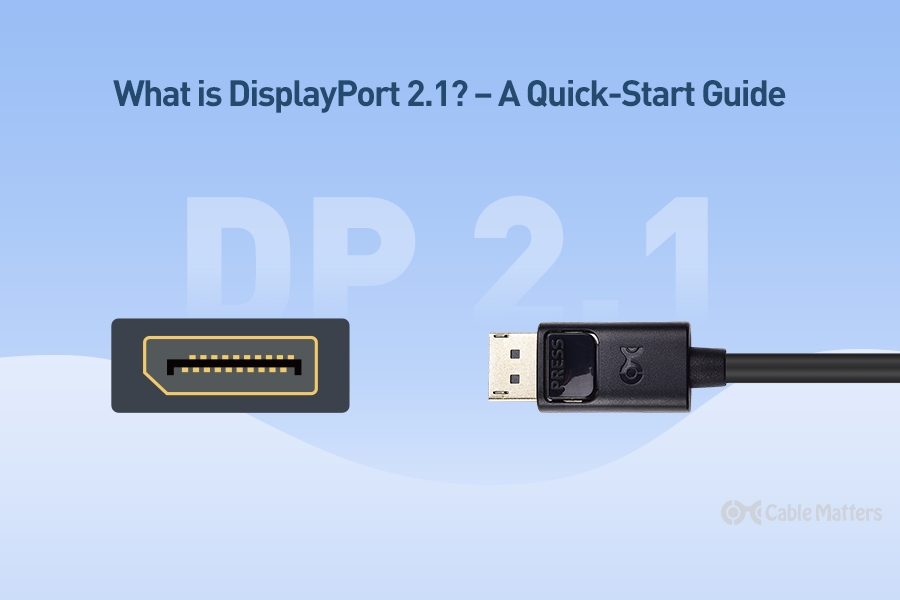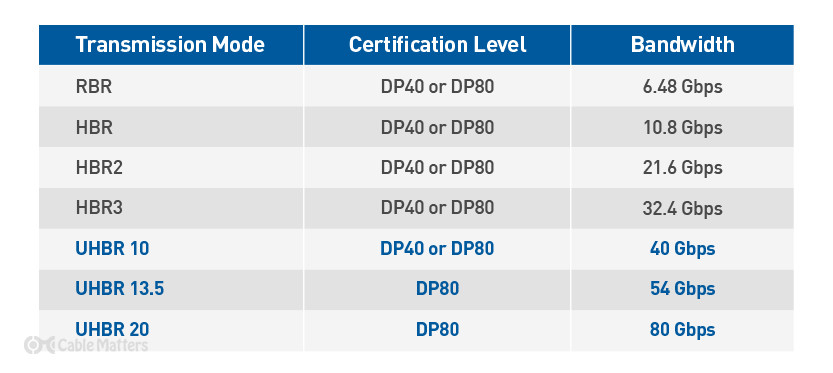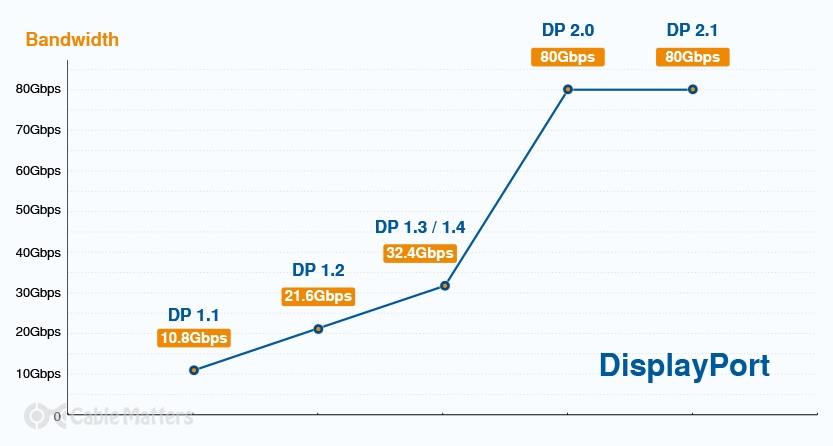
Navigation
DisplayPort 2.1 is an exciting new connection option for high-end computers and gaming monitors, but it’s going to become more mainstream throughout 2023. The latest evolution in DisplayPort technology, it’s likely to become the connection of choice for desktop computers the world over in the years to come, as though HDMI 2.1 gives it a run for its money, DisplayPort 2.1 is the most capable video and audio transmission medium available.
But despite this probable eventuality, DisplayPort 2.1 is not the easiest connector to use at the time of writing. There aren’t many supporting devices, and the ones that are available, are rather expensive. That will change in due time, though, so if you want to be ready for DisplayPort 2.1 as it rolls out across a wider array of devices and displays, you’ve come to the right place.
Here’s everything you need to know to get started with DisplayPort 2.1
What is DisplayPort?
DisplayPort is a popular digital display interface used primarily to transmit video from a desktop PC to a connected monitor, but it can also carry audio and data. It was introduced to replace legacy solutions like VGA and DVI, though retains backward compatibility with these and HDMI, through the use of adapters.
Often seen as a rival to HDMI, DisplayPort typically offers greater bandwidth, but it doesn’t have the same feature set.
The first generation of DisplayPort was introduced in 2006, and it’s gone through several successive generations since, though until the launch of DisplayPort 2.1, it hadn’t seen any serious revisions since DisplayPort 1.3 in 2014. DisplayPort 1.4 was largely a feature upgrade, rather than a performance improvement, though is currently the most popular form of DisplayPort, and can be found on many modern graphics cards and monitors.
DisplayPort uses a non-reversible header with 20 pins. It features a locking mechanism to keep the cable in place but is also available in Mini DisplayPort form without that safety feature. However, Mini DisplayPort has largely been phased out in recent years, in favor of USB-C, which offers DisplayPort compatibility through DisplayPort Alt Mode. That’s a way for USB-C cables to use the DisplayPort protocol to transmit video and audio at the same time as data to compatible displays.
DisplayPort cables support some of the highest resolutions and refresh rates possible, with DisplayPort 2.1 representing the most capable video transmission interface available today.
What is DisplayPort 2.1?
DisplayPort 2.1 is the latest generation of DisplayPort technology and like HDMI 2.1, it represents a major upgrade over its predecessors. Since no devices ever utilized the DisplayPort 2.0 standard, DisplayPort 2.1 is effectively the first to use all the advantages of that, with a few additional extras to better standardize the higher speed versions of DisplayPort cables, and better integrate the DisplayPort protocol with USB-C.
Moving forward, we are unlikely to see any DisplayPort 2.0 devices or displays, as a governing body, VESA, stated that DisplayPort 2.1 “defines the new normative requirement and informative guideline for component and system design.”
But what can DisplayPort 2.1 actually do? The answer is a lot.

The major upgrade with DisplayPort 2.1 is its bandwidth. It can support total bandwidths more than three times that of DisplayPort 1.4, thanks to a trio of new transmission modes. These have been designated Ultra High Bit Rate 10 (UHBR 10), Ultra High Bit Rate 13.5 (UHBR 13.5), and Ultra High Bit Rate 20 (UHBR 20). The numerical figures denote the per-lane data rate of the connection, which in the case of DisplayPort is quadrupled across its four lanes, potentially giving DisplayPort 2.1 a maximum bandwidth of 80 Gbps. That’s close to double that of HDMI 2.1 and comparable to the fastest USB4 Type-C cables.
Not every DisplayPort 2.1 cable, device, or display will support all three transmission modes but even UHBR 10 makes DisplayPort one of the most powerful video transmission cables. UHBR 10 cables and devices can handle 4K resolution at up to 144Hz, or 8K at up to 30 Hz. The higher data rates are even more impressive, hitting up to 240Hz at 4K, and even up to 85Hz at 8K. With Display Stream Compression (DSC) UHBR 20 can even handle a single 16K display at up to 60Hz, with HDR, and 10-bit color.
At lower resolutions, the potential for higher refresh rates is really exciting, too. DisplayPort 2.1 can handle 1440p at up to 500Hz, or 1080p at up to 900Hz. This could open up faster gaming monitors for the most competitive of players, and lead to even greater motion resolution in high-speed action games. It is also likely to be useful for next-generation virtual reality and augmented reality headsets, which will need higher resolution and refresh rate support for more immersive and comfortable usage.
DisplayPort 2.1 will also be usable over USB-C and will enable the transmission of high-speed data at the same time as powering multiple 4K displays simultaneously.
The massive data rate improvement of DisplayPort 2.1 was partly due to a change in the cable’s encoding system. It uses a much more efficient 128b/132b encoding, which results in much more efficient use of the available bandwidth. Ultimately giving you a usable 77.37 Gbps data rate from 80 Gbps total bandwidth.
As for features, DisplayPort 2.1 still doesn’t offer anything like HDMI’s ARC and eARC abilities, but it does have a new bandwidth management feature to better facilitate data and video transmission at the same time over USB-C cables and a new testing and naming convention for higher bandwidth DP40 and DP80 cables.
DisplayPort 2.1 vs. 2.0 vs. 1.4
DisplayPort 2.1 and DisplayPort 2.0 are almost identical as far as their specifications go, but there were some slight improvements as far as integration with USB-C cables and DisplayPort alt mode. However, both standards are leaps and bounds ahead of DisplayPort 1.4.
DisplayPort 1.4 supports the four traditional DisplayPort transmission modes: Reduced Bit Rate (RBR), High Bit Rate (HBR), High Bit Rate 2 (HBR2), and High Bit Rate 3 (HBR3), with a maximum bandwidth of 32.4 Gbps. The newer DisplayPort 2.0 and 2.1 standards support the newer UHBR transmission modes, offering up to 80 Gbps of total bandwidth, or 77.37 Gbps of raw data rate.

This was partly achieved through a change in encoding between the generations of cables. DisplayPort 1 through 1.4 used the older ANSI 8b/10b encoding system, where eight out of every 10 bits are data, with the final two being used for DC balancing (giving a roughly equal quantity of 1s and 0s in the transmission). That results in an efficiency of just 80%, leading to the overall 32.4 Gbps bandwidth of DisplayPort 1.4 cables being reduced to just 25.92 Gbps of total data rate.
DisplayPort 2.0 and DisplayPort 2.1 use a new 128b/132b encoding scheme that has an overall efficiency of 96.7 percent, helping it make the most of its 80 Gbps bandwidth, for a total data rate of 77.37 Gbps when using the UHBR 20 transmission mode.
All of that additional bandwidth opens up DisplayPort 2.1 and 2.0 to new resolutions and refresh rates. They can support 1080p at up to 900Hz, 4K at up to 240Hz, and 8K at up to 60Hz, as well as supporting HDR and 10bit color at various resolutions and refresh rates where it wasn’t possible on DisplayPort 1.4’s more limited bandwidth.
Although optional, the newer DisplayPort standards can also support VESA’s Panel Replay technology, which makes it possible for pixels on a display to not have to refresh if displaying the same static content. That reduces power consumption from the display when there are static elements on the screen, like logos, or heads-up display elements in games.
DisplayPort 2.1 and DisplayPort 2.0 are functionally identical, with only some minor improvements to the standardization of cable integrity with version 2.1 and new naming conventions for UHBR 13.5 and UHBR 20 cables. However, since no devices or displays have ever been released with support for DisplayPort 2.0, and DisplayPort 2.1 is now considered the modern DisplayPort standard, it seems likely that we will only ever see DisplayPort 2.1 devices and displays.
DisplayPort 2.1 vs. HDMI 2.1
DisplayPort 2.1 and HDMI 2.1 are the two video and audio transmission cable standards that are set to dominate the early to mid-2020s when it comes to consumer devices. Both support ultra-high definition resolutions like 4K and 8K, and high refresh rates of 120Hz or more at 4K. That makes them well suited to supporting the latest, and next-generations of desktop PCs and laptops, as well as game consoles.
However, there are some major differences between them, most notably that DisplayPort 2.1 is much more performative. Where it has a maximum data rate of 77.37 Gbps, HDMI 2.1 can only manage a usable data rate of 42 Gbps. That’s still powerful enough for 4k 120Hz gaming on the Xbox Series X or PlayStation 5, but it can’t do much more than that.
DisplayPort 2.1, however, can go much further, hitting up to 240Hz at 4K, and even up to 85 Hz at 8K without any kind of compression. HDMI 2.1 can use DSC to match that, but that’s not ideal for gaming and other latency-sensitive tasks.
Still, HDMI 2.1 does support ARC and eARC, enabling leaner cabling on your A/V entertainment system, which DisplayPort 2.1, or any other generation of DisplayPort for that matter, cannot do. HDMI 2.1 is also widely available, on both source devices like the latest games consoles, UHD Blu-ray players, and many desktop PCs and laptops.
DisplayPort 2.1 on the other hand, is almost non-existent. At the time of writing, there are only a few source devices available that can output to DisplayPort 2.1, and only a couple of displays that can receive the signal. This is likely to change over the coming year, though. DisplayPort 2.1 will see greater support among display manufacturers and as new, more affordable graphics cards are released as part of the latest generations, we should see wider adoption of the DisplayPort 2.1 connection, too.
What is DisplayPort 2.1a?
DisplayPort 2.1a is the latest update announced by the Video Electronics Standards Association (VESA) on January 8, 2024, marking a significant enhancement in the DisplayPort technology. This iteration introduces the DP54 cable specification, replacing the former DP40 UHBR cable spec. The new DP54 spec elevates the DisplayPort standard by enabling support for up to four-lane UHBR13.5 link rates, reaching a maximum throughput of 54 Gbps over a two-meter passive cable.
The introduction of DisplayPort 2.1a essentially doubles the passive cable length for UHBR13.5 GPU-to-display connections, which previously necessitated a DP80 UHBR cable for support. This development significantly enhances flexibility for consumers in setting up their gaming or workstation environments, offering greater freedom in how devices are connected within a space.
With the DP54 cable specification, DisplayPort 2.1a supports both UHBR10 and UHBR13.5 sink and source devices. Monitors equipped with UHBR13.5 capability can achieve stunning resolution/refresh rate combinations, such as 8K2K at 240Hz or 8K4K at 120Hz across four lanes. Furthermore, while the DP40 cable spec has been phased out, existing DP40 cables have been rigorously tested and verified by VESA to comply with the DP54 cable spec, ensuring support for UHBR13.5 link rates.
DisplayPort 2.1a represents a forward leap in the evolution of display technology, providing enhanced performance and flexibility for high-resolution gaming, professional workstations, and beyond.
DisplayPort 2.1a is more than just a technical update; it's a commitment to pushing the boundaries of what's possible in display technology. As VESA continues to refine and evolve the DisplayPort standards, the bar is set ever higher for what displays can achieve. For tech enthusiasts and professionals alike, these are exciting times. The promise of more detailed, more fluid, and more accessible visuals is not just a dream; with DisplayPort 2.1a, it's rapidly becoming our reality.
DisplayPort 2.1 vs. 2.1a
In essence, while DisplayPort 2.1 established a new benchmark for display technology, 2.1a builds upon this foundation with substantial enhancements that cater to the demands of tomorrow’s digital content. Through increased bandwidth, extended cable length, improved interoperability, and superior visual capabilities, DisplayPort 2.1a is not just an update—it’s a transformative leap toward creating more dynamic, detailed, and lifelike visual experiences. This transition underscores VESA’s commitment to innovation, setting a new standard for what is achievable in the realm of digital display technology.
Delving into the world of high-end display technology brings us to the comparison between two groundbreaking specifications - DisplayPort 2.1 vs 2.1a.
Increased Bandwidth
The DP54 cable specification supports UHBR 13.5, offering a remarkable throughput of 54 Gbps over four lanes. This allows for seamless transmission of ultra-high-definition video, surpassing the capabilities of the DP40 cable specification.
Extended Cable Length
DisplayPort 2.1a doubles the passive cable length to two meters without sacrificing performance. This eliminates the previous need for a DP80 UHBR cable, offering users greater setup flexibility and ease in cable management for both gaming and professional workspaces.
Enhanced Compatibility
While maintaining backward compatibility, DisplayPort 2.1a ensures smooth infrastructure transition by validating DP40 cables for the higher DP54 performance standards. This strategic approach allows for seamless upgrades from earlier standards without hardware overhauls.
Superior Resolution and Refresh Rate
DisplayPort 2.1a supports more ambitious resolution and refresh rate combinations, such as 8K at 240Hz or 8K4K at 120Hz, setting a new precedent for immersive visual experiences in gaming and professional applications.
DisplayPort 2.1 Compatibility: What Devices Can I Use?
As of now, very few. DisplayPort 2.1 is a new technology and was effectively only launched at the end of 2022 with the debut of AMD’s RX 7900 XT and 7900 XTX graphics cards. At the time of writing, they are the only DisplayPort 2.1 source devices available so if you want to use DisplayPort 2.1 in early 2023, they are your only option. They’re compatible with a wide range of desktop PC motherboards and processors, so compatibility isn’t difficult, but they aren’t cheap, as both represent the flagship cards of AMD’s latest GPU generation.
Only two displays with DisplayPort 2.1 support have been announced so far, and neither is widely available at the time of writing. Asus has the ROG SWIFT PG32UQXR, a 32-inch 4K panel with a 160Hz refresh rate. It has a pair of DisplayPort 2.1 ports, as well as two HDMI 2.1 ports, for maximum support of the latest consoles and desktop computers.
Samsung has also announced a new version of its Neo G9 49-inch ultrawide gaming monitor, with a staggering 7,680 x 2,160 native resolution and 240Hz refresh rate. Although it’s marketed as 8K, it’s more like two 4K monitors sat next to each other (native 8K would be 7,680 x 4,320). It will, however, still need to use DisplayPort 2.1 to handle the massive amount of video data it will receive from a source device, leveraging the UHBR 13.5 transmission mode to achieve it.
Conclusion: What’s Next For DisplayPort?
In the immediate future, greater adoption of DisplayPort 2.1 will be where all the exciting action is with DisplayPort technology. We’ll see new, more capable displays that can leverage it for higher resolution and higher refresh rate support. We may see 1080p monitors at up to 900Hz – though the most impressive to date has been 360Hz, so it may take some time to get that high – as well as more 4K monitors at 240Hz without DSC being enabled.
As for future versions of the standard, VESA hasn’t announced anything just yet, but it’s no doubt working on what comes next. Our money would be on feature improvements over performance enhancements since we haven’t even begun to tap what DisplayPort 2.1 can do just yet, but there’s no doubt that years from now there will be faster and more data-dense connections in the DisplayPort line.